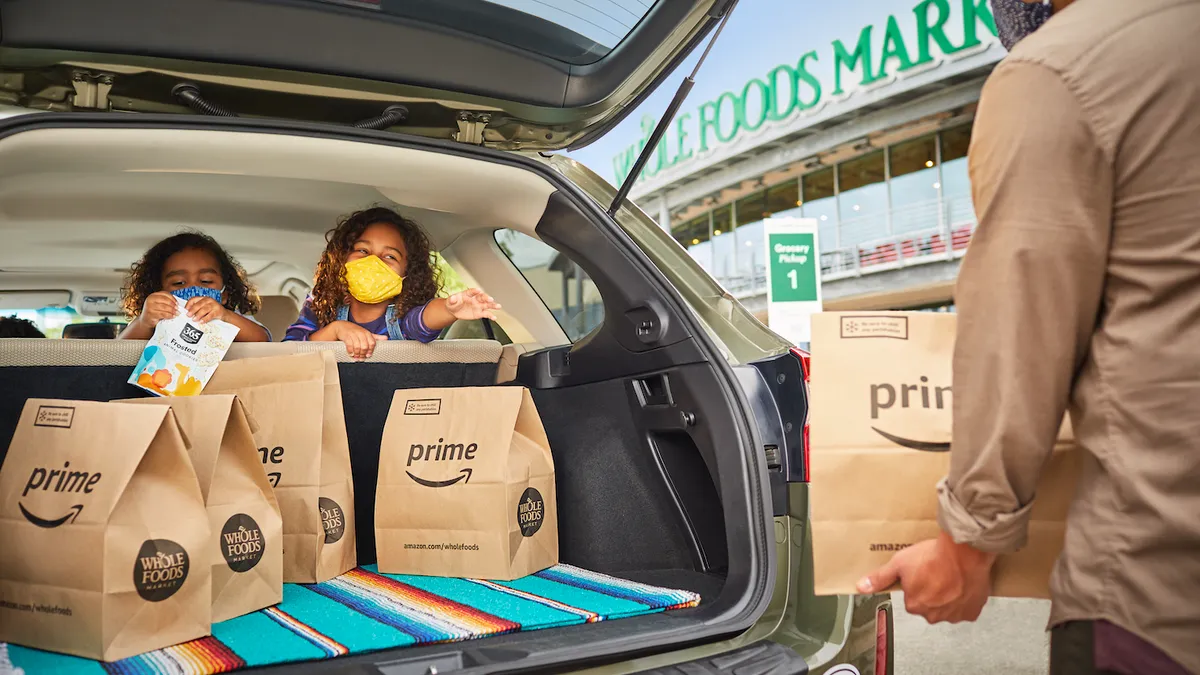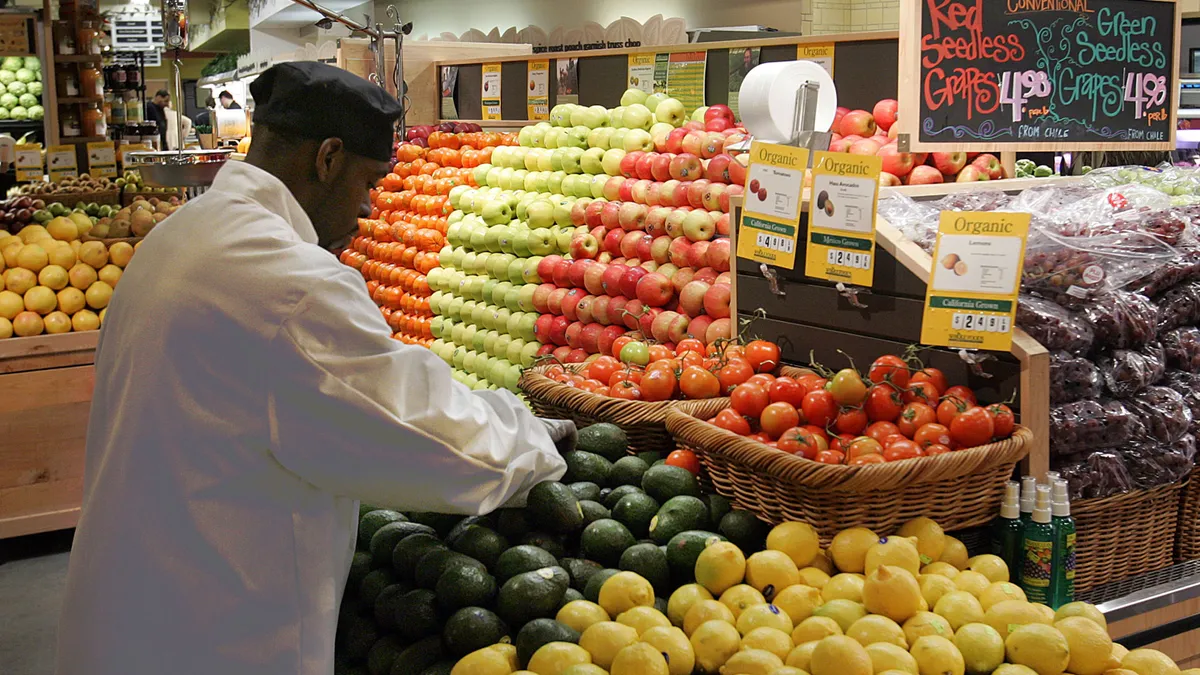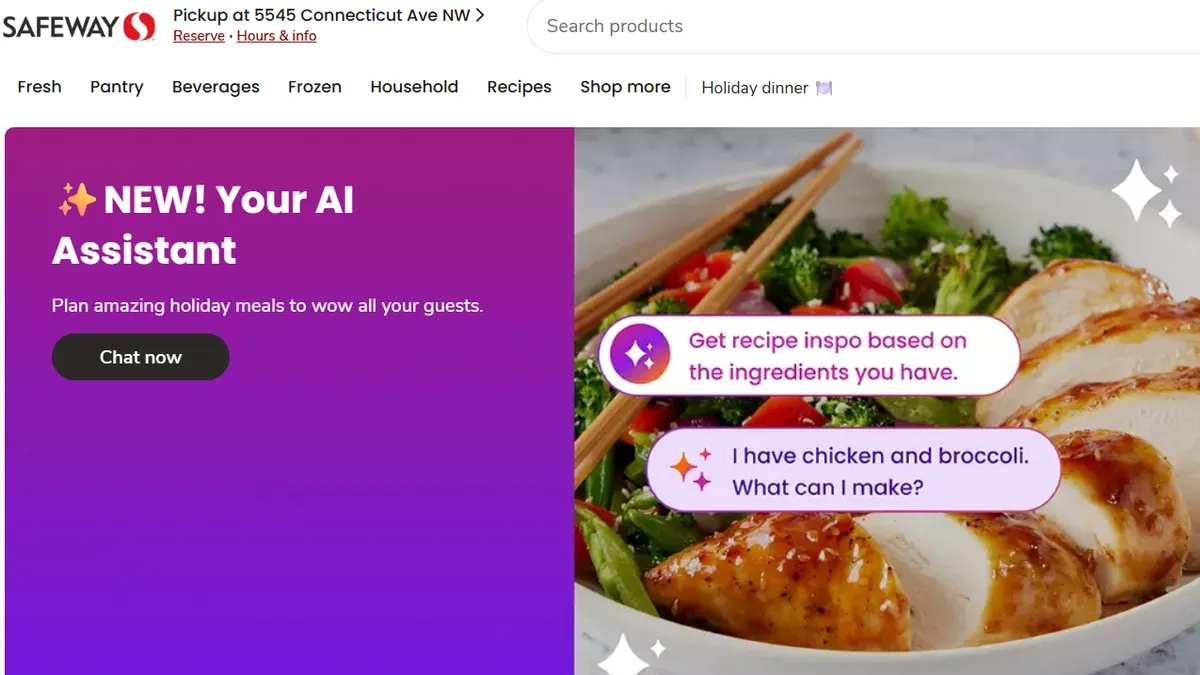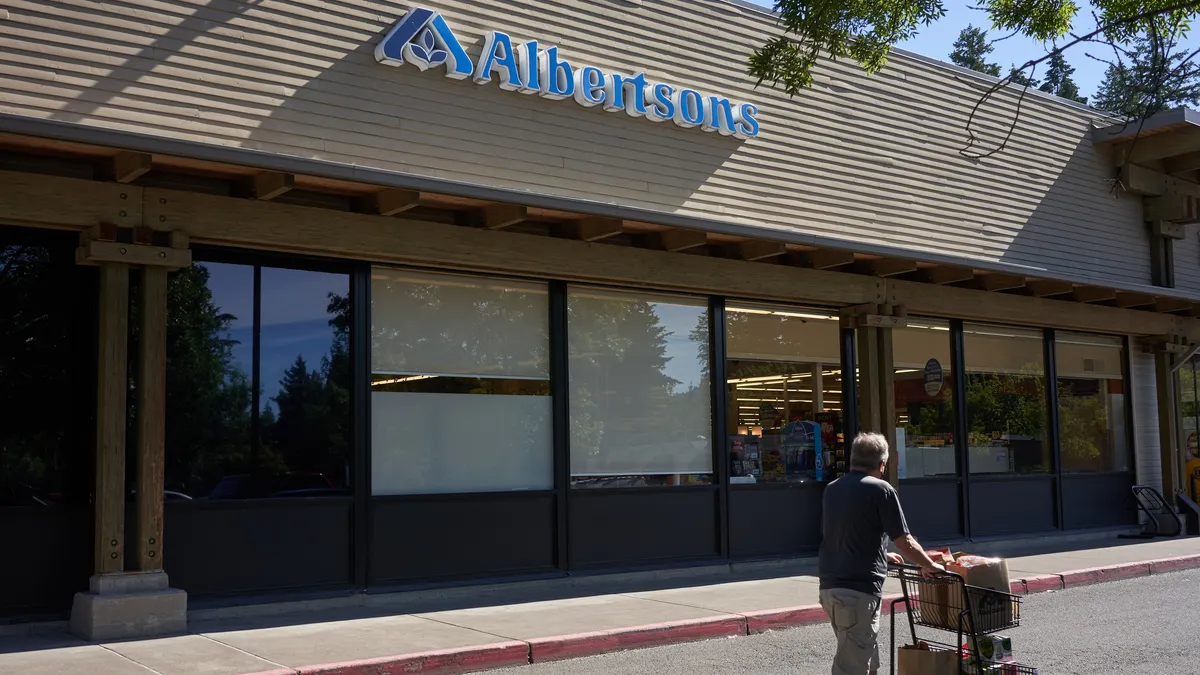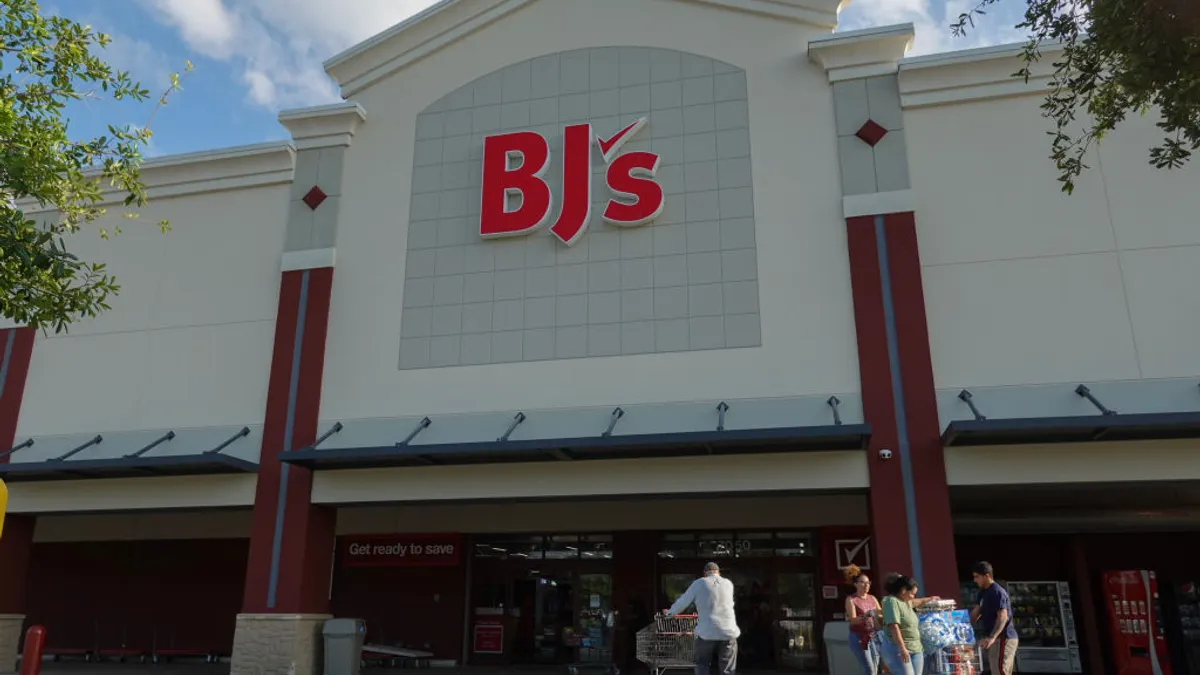After seeing grocery pickup orders take off during the coronavirus pandemic, grocers are looking to the future of the service and where to invest in the spectrum of pickup options.
“It's the equivalent of five years' growth within a matter of the month,” David Bishop, partner at Brick Meets Click, said about the e-commerce boom from late March to early April.
Brick Meets Click survey data has shown shoppers are opting for pickup over delivery during the pandemic, with 54% of sales coming through click-and-collect in June. The firm also found that 18% of monthly active users, which Bishop defined as households that make at least one online grocery order during the past month, only use a pickup service.
“So if you're a retailer that is in delivery only, there is a sizable segment of your market that isn't attracted to your service,” Bishop said.
Grocers and mass retailers responded to the surge by boosting their pickup capabilities. In Q1, Kroger added time slots and waived the $5 fee for its pickup service, which it offers at more than 2,000 stores. Amazon tripled its grocery pickup slots in Q2 and now offers the service at nearly 500 Whole Foods stores. Target, which increased its grocery pickup service availability to 1,500 stores and is continuing to expand the service, saw curbside pickup sales grow 734% in Q2.
Albertsons’ curbside pickup service is booming, outpacing delivery and increasing more than 1,000% during the grocer’s second quarter on a year-over-year basis, according to a recent earnings call. The grocery store chain is planning to expand curbside pickup to 1,400 stores — more than half of its stores — by the end of the fiscal year.
As pickup continues to remain popular, retail analysts said that grocers still have hurdles to overcome, like operational challenges and concerns about customer satisfaction.
Tory Gundelach, senior vice president of retail insights with Kantar Consulting, calls pickup a blessing and a curse for grocers. While it’s bringing in more orders and is less expensive than delivery for grocers and consumers, pickup ultimately leads to “significantly more volume coming through a less profitable mode of fulfillment” compared to in-store purchases.
Along with common challenges retailers are trying to solve with pickup, like shrinking wait times and addressing labor shortages, grocers face unique issues with optimizing the service, from keeping hot and cold items at the right temperature to inventory management that supports both in-store and online shoppers.
“I think the big shift has gone from the fact that, ‘Do we need click-and-collect?’ to the actual question, ‘Oh, I really need click-and-collect, but what kind of solution?’” Edith Väli, marketing manager for Cleveron, a firm that manufactures automated pickup solutions, said.
The perks of pickup-only spots
During the pandemic, grocers like Kroger, Whole Foods and Giant Eagle converted stores to pickup-only locations out of necessity. While most of these locations have reopened to shopper traffic, the idea of deploying more dedicated pickup facilities has gained traction as online grocery demand has stayed high.
Pickup lockers that securely store orders either at the store or off-premise have gained traction in recent years, with Hy-Vee among the fleet of grocers that have piloted the technology. There are now signs that interest in pickup lockers, which promise labor savings for retailers and more flexible collection times and locations for consumers, is increasing. Later this year, Albertsons will add contactless pickup lockers from Bell and Howell to select stores in Chicago and the San Francisco Bay Area.
Startups are also working on technology that adds automation to unmanned pickup. Bell and Howell also manufactures standalone pickup kiosks that can bolt onto stores or operate as standalone locations. The firm's "XL" solution includes seven separate automated kiosks that operate similar to ATMs, each with its own drive-up parking spot. The kiosks collectively hold up to 2,000 totes and keep items chilled below 40 degrees.
Cleveron, which teamed up with Walmart on its in-store pickup towers, works with grocers to offer pickup lockers with temperature-controlled zones for hot and cold groceries that shoppers can access via QR codes or PINs.
Cleveron’s grocery kiosk aims to be an outdoor solution that can solve last-mile challenges, Väli said. “You can put these units anywhere you like — next to the office buildings, in rural areas where you don't have a store so you basically kind of expand your business by just putting in one unit,” she said, noting that she envisions the U.S. having an open network of lockers where couriers can store parcels from multiple vendors.
Gundelach said she's seen pickup-only locations like dark stores and pickup points generating significant industry buzz, and said these options can be more profitable on a per-order basis because they take out the complexity of operating an in-store environment.
But before retailers jump to open dark stores, they should consider the in-store purchases by shoppers getting their pickup orders, she said.
“There are still a lot of dollars to be had in that add-on purchase,” Gundelach said, adding that retailers may need a blend of both pickup-only and pickup that draws consumers to the store. Kantar research this year found that 54% of click-and-collect shoppers frequently or sometimes shop in-store when picking up items specifically shopping for grocery — a 33% increase in the number of shoppers who did so compared with last year.
Whether relying solely on stores or incorporating off-site locations, retailers will need to move pickup fulfillment off their selling floors as demand rises, said Bill Aull, partner at management consulting firm McKinsey & Company. Using backrooms, dark stores or micro-fulfillment centers to pick online orders could help address inventory challenges by keeping shoppers and pickers separate and speed up picking, he noted. Replacing or reducing human employees with robots could add another layer of efficiency to the pickup process.
“I think the big shift has gone from the fact that, ‘Do we need click-and-collect?’ to the actual question, ‘Oh, I really need click-and-collect, but what kind of solution?’”

Edith Väli
Marketing manager, Cleveron
Gaining control over consumer experiences
As grocers hustle to start or ramp up their pickup services, many have turned to third-party companies to provide everything from labor to order-optimizing software and hardware.
Gundelach said she expects grocers will continue to leverage exclusive partnerships with technology and operation companies, pointing to Kroger’s exclusive partnership with Ocado as an example.
“I think that any time you’re playing catch-up, people are more likely to leverage the partner or the buy option versus the build option, but I do think over time we'll see some of that shift back into retailers building their own capabilities,” Gundelach said.
By bringing pickup capabilities in-house, grocers would potentially increase profitability and gain more control over consumer data and experiences. In a move for more autonomy, Aldi and Sprouts recently replaced Instacart’s in-store shoppers with their own employees, as needed, CNN reported in July.
With data and planning, Aull said grocers can improve their assortment availability and avoid substitutions — the top reason causing shoppers to switch retailers in March and April, McKinsey found.
Gundelach expects more companies will leverage their past sales history and their clickstream data, particularly when it comes to grocer sales tied to a loyalty card, to personalize and incentivize add-ons.
Matthew Russo, the COO and CMO of Gimbal, said that the future in pickup technology will offer predictive ordering with push notifications prompting shoppers to replenish orders, using location data to ask if they want to pick up their order from a nearby store.
Retailers wondering how they can curate experiences online when they don’t have the smells of fresh products and free samples and demonstrations at the stores can start by changing up their online content regularly, Nick Nickitas, founder and CEO of e-commerce platform Rosie, said.
“You'll see stores change their retail formats … it'll be kind of custom dressed up for holidays or Thanksgiving or for Valentine's Day, but it hasn't really translated in the digital space,” Nickitas said. “Most grocery e-commerce sites look the same each and every time. That's boring for shoppers.”
From menus to digital merchandising, grocers can use customization to increase the appeal of pickup orders, Nickitas said.
Independent grocers are investing in customer service and highlighting local flavors and vendors as their strengths driving pickup sales, Nickitas said. Meanwhile, chains are implementing technology at a faster pace and creating a highly branded experience with clear signage and designated parking spots: “That stuff is super attractive because it really makes the online and in-store experience feel married together,” Nickitas said.
Investing in integrated infrastructure
In the race to make pickup more enticing and profitable, grocers are also investing in technologies that optimize order picking and get groceries out to shoppers faster.
SpartanNash, Lowes Foods and Giant Eagle have recently tapped Radius Networks’ geolocation software called FlyBuy. Gimbal offers location technology that lets grocers know where customers are and gives customers updates on their orders. The next version of Gimbal’s software will incorporate dynamic location tracking that uses where a person is when they place their order to help figure out estimated arrival times, along with taking traffic patterns and transportation choices into account, Russo said.
Meanwhile, firms like ShopperKit that have developed labor technology that shows workers when and how to pick products, organizes picking into zones and helps finalize orders for staging are investing in further innovation and linking up with other tech firms to offer end-to-end pickup solutions. Recently, the company linked up with e-commerce software firm Mercatus and Radius Networks to offer a "white-labeled, retailer-owned experience" that includes platform management, picking technology and geofencing capabilities.
Research shows these various steps are reducing order wait times — but perhaps not enough to drive significant loyalty to the service. The average wait time for curbside pickup with grocers dropped from 5 minutes and 21 seconds in 2019 to just over 5 minutes this year, according to a recent study by Rakuten Ready. Shoppers who waited under two minutes for their pickup order from QSRs, restaurants, retailers and grocers were four times more likely to make a future purchase, the study found.
While none of the grocery retailers studied hit the two-minute mark, the Rakuten Ready report found Walmart Grocery was the fastest at 2 minutes and 6 seconds and had the largest year-over-year drop from just over 7 minutes in 2019. H-E-B and Albertsons had the longest wait times at nearly 9 minutes and more than 7 minutes long respectively.
Grocers have a variety of software to choose from for integration into their e-commerce platforms. “It can get confusing if it’s not done right. The best strategy is to have it [the technology] seamlessly integrated,” Mike Demko, the founder and CEO of Locai Solutions, said.
Locai, a white label, end-to-end platform provider, is trying to solve that problem by integrating technologies, like FlyBuy, into one e-commerce platform for grocers and consumers. “As the e-commerce platform provider, we can plug and play with some of these technologies and be a systems integrator of sorts,” Demko said.
Locai offers its own suite of solutions, including a multi-order picking tool, capacity planning and capacity management tools. To fix inefficiencies on the operations side, Locai’s technology allows pickers to shop multiple orders at the same time and creates zones in the grocery store to reduce footsteps.
“Time is your enemy. If you can minimize the travel time for a particular person filling those orders, you can maximize productivity for those people as well,” Demko said.


